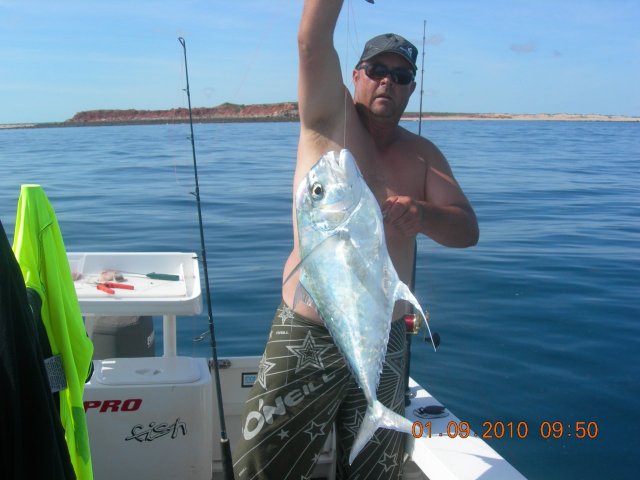cape leveque
Submitted by leesfishin on Sat, 2011-07-02 07:45


cape leveque trevelly .biggest dimond trevelly ive caught

| |
|
|
User loginNavigationSearchWho's onlineThere are currently 5 users and 3889 guests online.
Online users
|
cape leveque
Submitted by leesfishin on Sat, 2011-07-02 07:45
 cape leveque trevelly .biggest dimond trevelly ive caught |
New forum topics
Recent comments
|
CCC
Posts: 539
Date Joined: 29/03/10
Nice fish, what make of boat
Nice fish, what make of boat is that. Like the baitboard and live bait tank.
CCC
suicidal gardie
Posts: 52
Date Joined: 05/05/10
Trailcraft
Trailcraft is my guess, I'd say a 540 or 640 profish?
southcity104
Posts: 1659
Date Joined: 27/01/09
nice trev!
That one could be pennant trevally though.
"Its a life style job"
MattMiller
Posts: 4171
Date Joined: 15/06/09
Yeah,
looks like an African Pompano (PennantFish).
Pennantfish - Alectis ciliarisAlso known as African Pompano, Pennantfish are similar to Diamond Trevally (Alectis indica) but Pennantfish have a more rounded upper head profile than the angular head of the Diamond Trevally. The eye of the Pennantfish is closer to the upper jaw than that of the Diamond Trevally. Pennantfish are silvery metallic blue green on the upper body and silver elsewhere and the head is generally darker than the body. There is a diffuse dark blotch on the opercle and in maturing adults, there may be a black blotch at the base of the soft dorsal fin.
Juvenile Pennantfish have extremely long trailing filaments from the dorsal and anal fins, which are not present in adults. The base of these trailing filaments are dark blue to black. Young fish are deep bodied with five or more chevron shaped dark bars.
Pennantfish have been recorded at 23kgs and 1.5 metres in length.
They are considered average eating.
In Australia, Pennantfish are known from Dunsborough Western Australia, around the tropical north to southern New South Wales, living in inshore and contintental shelf waters to 100m.
Close relation to the Diamond Trevally.
Diamond Trevally - Alectis indicaOften confused with the Pennantfish (Alectis ciliaris), Diamond Trevally can be distinguished by the more angular shape of the head and nape vs the more rounded head of the Pennantfish. There is a distinct hump in the head profile above the eyes (caused by a slight concavity near the eyes) and there is a wider space between the eye and mouth of the Diamond Trevally than the Pennantfish. Diamond Trevally are deep bodied and uniformly silver, often reflecting blue, pink and green on capture (also known as Mirror Fish). They have a large forked tail and long curved pectoral fins.
Juveniles have four to seven broad, darkish bands and the dorsal fin has long filaments. There is no black blotch at the base of the filaments.
They grow to 25kgs and 1.65 metres.
Diamond Trevally are considered poor to average eating having dark flesh. They do not freeze well and should be bled immediately on capture.
In Australia, Diamond Trevally are found from south-west Western Australia around the tropical north down to the central coast of New South Wales, over coral reefs in coastal waters to 100metres. They feed on fish, squid and crustaceans.
leesfishin
Posts: 233
Date Joined: 27/03/11
yes is a trailcraft pro
yes is a trailcraft pro fisher 5.1m great boat for up north,easy to tow & launch etc!!
cool pennant fish, you learn somthing every day. !!
have caught a few small ones over the years , ever that big tho